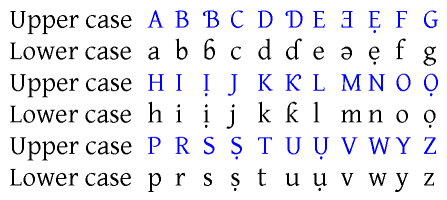Zwunzwuo a̱lyem a̱mgba̱m Naijeriya
Ta̱mpi̱let:Contains special characters Zwunzwuo a̱lyem a̱mgba̱m Naijeriya ji yet sot zwunzwuo Lati̱n 33 ja nang A̱ka̱wa̱tyia̱ A̱lyem A̱byin ka ku kpaat ji̱ yet zwunzwuo kidee a̱ni mi̱ cet ndyia̱ 1980 hu. Á̱ fa ji̱ na maai di̱ lyuut a̱mgba̱m lilyem Naijeriya hu di̱ mi̱n nyian ta̱m ma̱ng zwunzwuo nang á̱ tyei fafaan a̱ni.[1]
Nkhang[jhyuk | jhyuk a̱tyin ka]
Á̱ lyiat di̱ lilyem ma̱ a̱di̱di̱t vwuon hwa ma̱ a̱byin Naijeriya. Zwunzwuó lyuut Lati̱n vwuon ji ni̱ tyia̱ dyem di̱ nyian ta̱m ma̱ng a̱yaatapi̱raita. Mi̱ ce ndyia̱ 1980 na A̱cyian A̱lyem A̱byin ka si̱ kyiak kpa̱t byi̱k zwunzwuo-a̱lyem jhyiung ji̱ na yet myim lyuut a̱mgba̱m lilyem a̱byin ka ji̱ ka shai lyuut A̱la̱ra̱ba hu nang á̱ ku jhyi á̱ sak di̱n jen tyok á̱nietcen hu a̱ni, á̱ si̱ ntsa ma̱ng khwom hu nang a̱tyulyenlilyem wu Kay Williamson ku jhyi a̱ni ma̱ a̱lyia̱ 1981. Á̱ ku jhyi kyangbwak ga̱lyuut hu tsi̱tsak a̱lyia̱ 1985-86 mbwak Edward Oguejofor ma̱ng Victor Manfredi, di̱ tung mbwak ma̱ng sot NLC ji, mbeang beang lyennkyangta̱m mbwak Hermann Zapf.
Zwunzwuó[jhyuk | jhyuk a̱tyin ka]

If a Unicode font is installed with the Pan-Nigerian glyphs, then a table, such as the one below, should be seen:
| Upper case | A | B | Ɓ | C | D | Ɗ | E | Ǝ | Ẹ | F | G |
| Lower case | a | b | ɓ | c | d | ɗ | e | ǝ | ẹ | f | g |
| Upper case | H | I | Ị | J | K | Ƙ | L | M | N | O | Ọ |
| Lower case | h | i | ị | j | k | ƙ | l | m | n | o | ọ |
| Upper case | P | R | S | Ṣ | T | U | Ụ | V | W | Y | Z |
| Lower case | p | r | s | ṣ | t | u | ụ | v | w | y | z |
The acute ( ´ ), grave ( ` ) and circumflex ( ˆ ) accents are also used to mark High, Low, and Falling tone respectively. Mid tone (in languages which contrast High, Mid, and Low) is left unmarked.
Kibwot[jhyuk | jhyuk a̱tyin ka]
The following typewriter keyboard was produced for the NLC by Olivetti:[2]
| ˆ ˊ |
" 2 |
/ 3 |
− 4 |
₦ 5 € |
= 6 |
_ 7 |
ǀ 8 |
( 9 |
) ? |
Ɗ |
Ƙ |
⌫ Backspace | ||||||||||||||||||||||||||||||||||||||||||||||||
| ↹ Tab | ˉ ˋ |
W |
E |
R |
T |
Y |
U |
I |
O |
P |
Ụ |
Ị |
||||||||||||||||||||||||||||||||||||||||||||||||
| ⇫ Caps Lock | A |
S |
D |
F _
|
G |
H |
J _
|
K |
L |
Ọ |
Ẹ |
Ǝ |
||||||||||||||||||||||||||||||||||||||||||||||||
| ⇧ Shift | Z |
Ɓ |
C |
V |
B |
N |
M |
; , |
: . |
Ṣ |
⇧ Shift | |||||||||||||||||||||||||||||||||||||||||||||||||
| Ctrl | ⊞ | Alt | Space bar | Alt Gr | Fn | ≡ | Ctrl | |||||||||||||||||||||||||||||||||||||||||||||||||||||
On this typewriter keyboard layout the letters Q and X were not mapped as they were not part of the alphabet, and digits 0 or 1 had to be entered as capital letters O and I. Keys in grey (for modern computers) were missing.
On modern keyboard for computers, the distinctive digits 0 and 1 are placed on the unshifted positions of keys of first row (like other digits), the letter Q is mapped like on standard QWERTY layouts, but dead keys at start of the first and second row need to be moved to the 102nd key on start of the first row (reducing the width of the left shift key), and to the shifted position of the new key assigned to digit 0 on the first row.
In all cases, the Enter key may vary between this L-shaped key on two rows, and the horizontal key on the third row only (moving the key assigned to letter Ǝ to the end of the second row).
Jét a̱bwoi[jhyuk | jhyuk a̱tyin ka]
Some onscreen smartphone keyboards like Swiftkey, Touchpal, Multiling and African keyboards have full support for Pan-Nigerian alphabets.[3]
Bu nwuan[jhyuk | jhyuk a̱tyin ka]
- Zwunzwuo-a̱lyem Lilyem Kemerun da̱ A̱ka̱nyiung
- Zwunzwuo-a̱lyem Afrika
- Zwunzwuo-a̱lyem ya̱fang Afrika
- Zwunzwuo-a̱lyem Dinka
- ISO 6438
- Zwunzwuo-a̱lyem Kidee mbwak Lepsius
- Zwunzwuo-a̱lyem Viyetnam
Ya̱gyit ma̱ng ya̱fang[jhyuk | jhyuk a̱tyin ka]
- ↑ Kasali, A. A.; Jimoh, K. O.; Adeagbo, M. A.; Bello, S. A. (2021-03-20). "Web-Based Text Editing System for Nigerian Major Languages". Nigerian Journal of Technology. 40 (2): 292–301. doi:10.4314/njt.v40i2.15. S2CID 240185001.
- ↑ Pan-Nigerian Typewriter Design, archived
- ↑ Taiwo, Joseph. "Yoruba Keyboard For Android". W3Techy. Retrieved 2019-04-30.
| Lilyem Naijeriya | |
|---|---|
| A̱do • A̱ghwangkpang • A̱kum-a̱cyi • Á̱niet-a̱tyin • Á̱nietmangfwuo • Á̱niet-swak • Á̱niet-tswaywan • Á̱nietza̱fan • Bishyi • Bokyi • Byoot • Ce • Daa • Fa̱taa • Ga̱ra • Ibibyo • Idoma • Igwong • Ishan • Ishekiri • Isoko • Izere • Izon • Jhyuo • Jukum • Kpat • Kutyep • Kuu • Kuut • Kyibaku • Mada • Mumuye • Mwagha̱vwut • Nupe • Sunkurum • Tsamyia̱ • Tyap • Tyen • Urobo • Ziyaniet |

